Wetland Ecosystems
Freshwater Marshes, Wet Prairie, Hardwood Swamp, Cypress Swamp, Mangrove Forests, River Floodplains
Freshwater wetlands form in low-lying areas such as depressions or sloughs when groundwater levels are at or above the surface of the surrounding landscape, or where there is an underlying strata of "hard pan" or "marl", a compacted clay like mud mixed with calcium that slows or stops drainage to create persistent flooded conditions. This is common in South Florida and the the Everglades.
The length of time that these wetlands remain flooded is referred to as the hydro-period. Hydro-periods vary in length and may be as brief as a couple of weeks or as long as a year or more. Some wetlands never dry out completely while others dry out every few years or only during extreme drought.
Florida's aquatic freshwater and marine life, including many commercial and sport fish, depend on these marshes and swamps for feeding grounds and nurseries for their young. Florida's wetlands also provide outstanding recreational opportunities and are a significant source of revenue for the state.
Originally covering about 60 percent of the states landmass, wetlands have been reduced by drainage and subsequent development to less than half of that amount. Wetlands are also important to Florida's human population - swamps, marshes, ponds, lakes and river floodplains hold, filter and slowly release huge amounts of rainwater into the aquifers that are central and southern Florida's sole source of fresh water.
(Florida has lost over 40% of its wetlands since becoming a state, many remaining wetlands are small remnants of what were once much larger contiguous ecosystems.)
Wetland habitat types may be named according to the dominate plant species present, a Sawgrass Marsh for example, or for a geological feature - a Basin Marsh or Cypress Slough are two examples.
Different types of wetlands are often adjacent to one another, for example a cypress or hardwood swamp contained within a freshwater marsh or on the margins of ponds and lakes. River floodplains often create and/or include marshes, swamps,sloughs and ephemeral ponds that support a large number of plants, birds and animals.
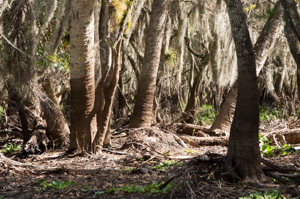
The picture above was taken on the Myaka River floodplain, the water-stained lower portion of the tree trunks indicates a depth of about 3-4 feet at flood stage. Seasonal flooding deposits nutrients from the river sediments and other debris, note the aquatic water hyacinth (Eichhornia crassipes) left by the receded water.
The picture below shows the amazing variety and amount of plant life the nutrient rich soil that is created on the floodplain supports - ferns, lilies, mosses, sedges and a variety of herbaceous plants carpet the ground. River floodplains often contain ephemeral ponds, marshes and swamps created by the periodic floods. Many amphibians, reptiles, small mammals and insects also find homes and food in the thick vegetation.
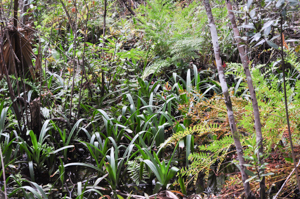
Mangrove Forests and Swamps
Mangrove forests are among the most biologically diverse ecosystems on earth, mangroves grow from approximately 25 to 28 degrees north and south latitudes, in Florida mangroves grow southward from a "frost line" extending from Levy County on the Gulf coast to St. John's County on the Atlantic coast with the highest concentrations of trees found further south on the peninsula.
Mangrove forests are composed of species of plants that have adapted to life on the protected shorelines of marine estuaries and bays. Mangroves are able to grow in water with varying amounts of salt concentrations ranging from the coastal waters with a very high salt content, to almost completely fresh water.
Red mangrove (Rhizophora mangle), black mangrove (Avicennia germinans), and white mangrove (Laguncularia racemosa) are the three mangrove species in Florida, present with the mangroves is Buttonwood (Conocarpus erectus) sometimes called Buttonwood mangrove although it is not a true mangrove tree. Some other common plants associated with mangrove forests in Florida include salt-wort, glasswort, Christmas berry, sea-blite, and salt marsh cordgrass.
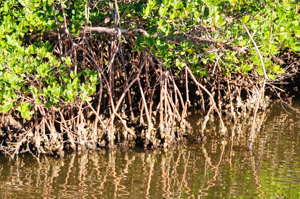
Pictured above - Red mangrove tree prop roots, exposed at low tide showing oysters and barnacles attached to them

The red mangrove tree has long, red, arching prop roots and is actually found growing in the water or very close to it on saturated sand, these roots serve to prop the tree up in the wet sand or water, provide oxygen to the tree, excrete excess salt and provide safe spawning and hatcheries for many species of fish. Growing or living among the roots are shrimp, crabs, sponges, oysters, barnacles, sea anemones and other invertebrates, marine plant life and the "fry" (babies) of many fish species. Bald eagles, herons, falcons, bitterns, spoonbills all call the mangroves home.
On the upland side of the red mangroves are the black mangrove, these are quickly identified by the many pneumatophores - finger-like roots that protrude upward from the soil around the base of the tree, these provide oxygen to the root system of the tree in the saturated soils where they grow. White mangrove grows further upland from this, along with buttonwood.
Buttonwood (Conocarpus erectus), sometimes referred to as buttonwood mangrove is very common in the periodically flooded areas where white mangroves also grow.
All mangrove trees are protected by law and cannot be removed, trimmed, or disturbed without a permit from the Florida Department of Environmental Protection.
Wet Prairie
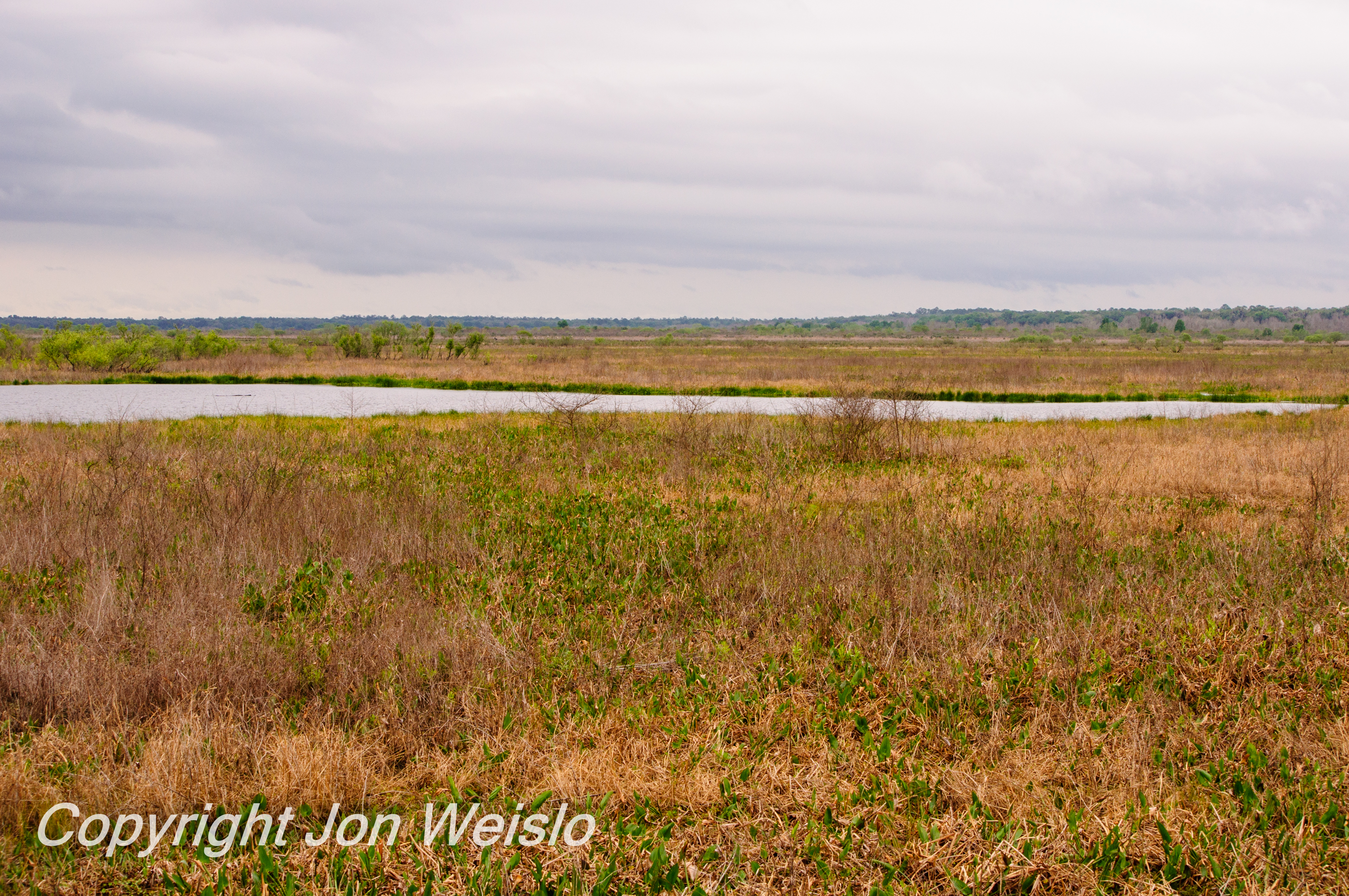
Wet prairies are characterized by a level or gently sloping topography lying between lower depression marshes or swamps, or adjacent to slightly higher mesic flatwoods or dry prairie, and as having saturated but not flooded (or rarely flooded) soils with a community of herbaceous plants. Wet prairie ecosystems are mostly devoid of shrubs or trees with the exception of a few scattered Wax myrtle or Carolina willows.
There are three variations of wet prairie in Florida: Pitcher Plant Prairies in the panhandle are often dominated by various species of pitcher plants, such as calcareous the wet prairies of the central and southern central areas of the peninsula, Cutthroat Seep, present on the east and west margins of the Lake Wales Ridge, is dominated by the endemic Cutthroat grass.
The wet prairies of Florida are home to the most diverse community of species in the United States. Plants associated with the wet prairie include sedges, muhly grass, cutthroat grass, sawgrass, sundew and a variety of flowering herbaceous plants including marsh pinks, coreopsis species and meadow beauty.
Freshwater Marshes
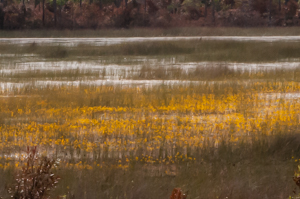

Freshwater marshes are flooded wetlands that occur at the mouths of rivers, on river floodplains, in woodland depressions with poor drainage, and on the margins of lakes and ponds. Water depth may range from a couple of inches up to 6 feet in areas of deeper water, or "marsh lakes." These lakes never dry out completely, providing refuge for many animals during periods of extended drought. Some marshes are flooded year-round, while others are more or less dry during Florida's dry season. Plant life consists of emergent sedges and grasses, bladderwort, cattails, bulrushes, and pickerelweed.
The Florida Everglades in South Florida have historically stretched as far north as Lake Okeechobee and contain the largest contiguous freshwater marsh system in the United States. Sawgrass marshes once dominated the northern portions of the Everglades before the land was drained and planted with sugarcane. Sawgrass (Cladium jamaicense) is actually not a grass but a sedge that can grow to over 9 feet tall. It has sharp saw-toothed blades and forms dense thickets where flooded conditions are present year-round or nearly so. This is because in areas that dry out periodically the exposure to sunlight and air oxidizes accumulated sediment leaving sandy soil with few nutrients, in places that don't dry out the accumulation of dead vegetation and sediments contribute to a nutrient rich, acidic "muck" that can support a larger variety and denser population of plants.
Cypress Strand, Cypress Dome
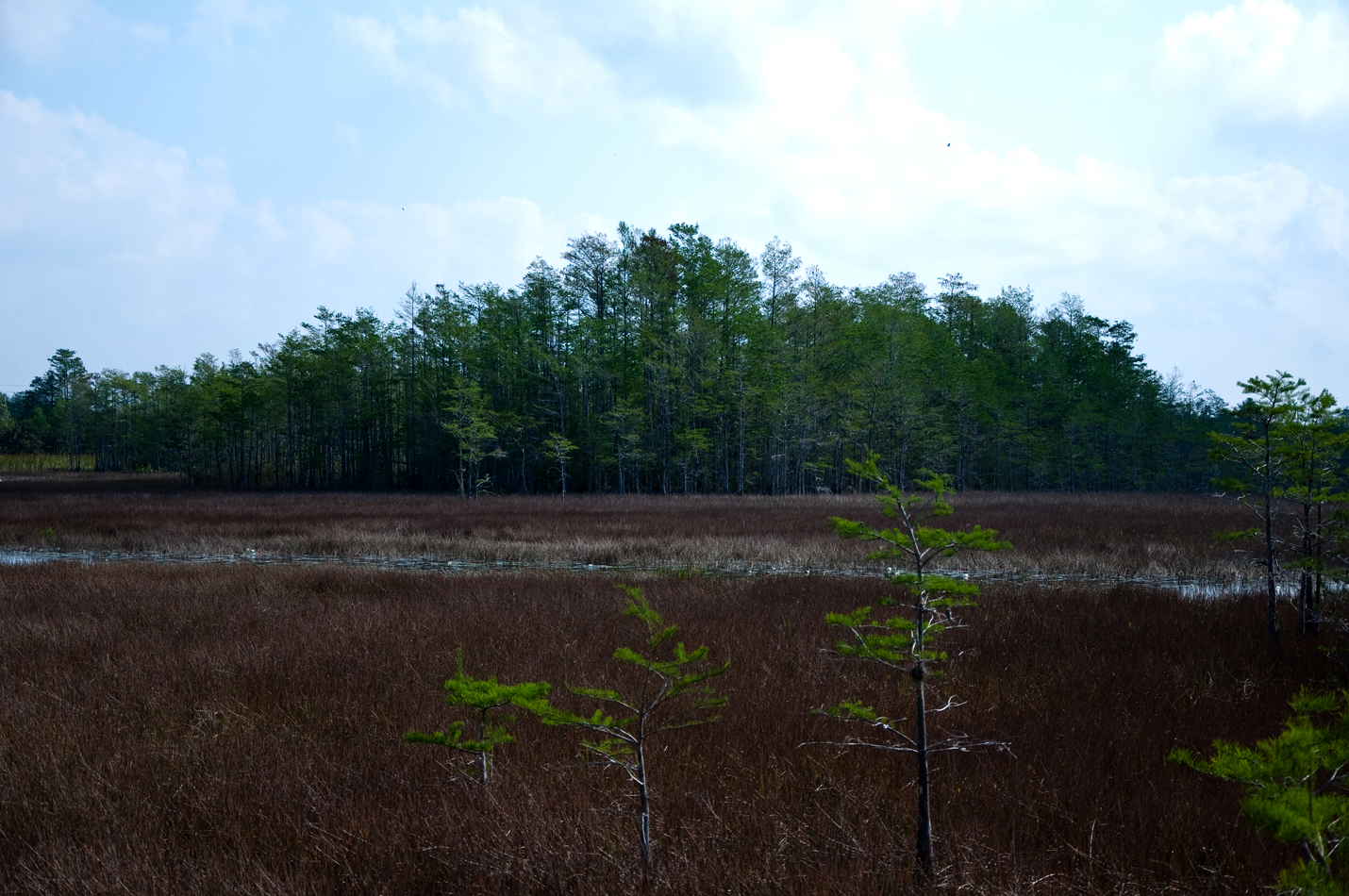
Dominated by Bald Cypress, sometimes with a mix of other hardwood trees. The length of time that Cypress stays flooded determines what understory plants are present. In addition to the mosses, ferns, and epiphytic or "air plants" that grow everywhere among the cypress, there may be aquatic, emergent, and herbaceous plant species present.
A cypress dome is named for its shape, with taller trees in the center and smaller, younger trees on the perimeter. Cypress Strands usually follow a slough, resulting in the strand shape, which is longer than it is wide, forming a "river of trees".The margins of cypress domes and strands generally support a much higher number of plant species than the interior and often transition to wet prairies or marshes.
Hardwood Swamps
Swamps are distinguished from marshes or other wetlands by having a canopy formed of various hardwood trees, or a mixture of hardwoods, cypress, and sable palms. This type of habitat occurs on river floodplains, sloughs, depressions or other locations that have a lower elevation than the surrounding landscape.
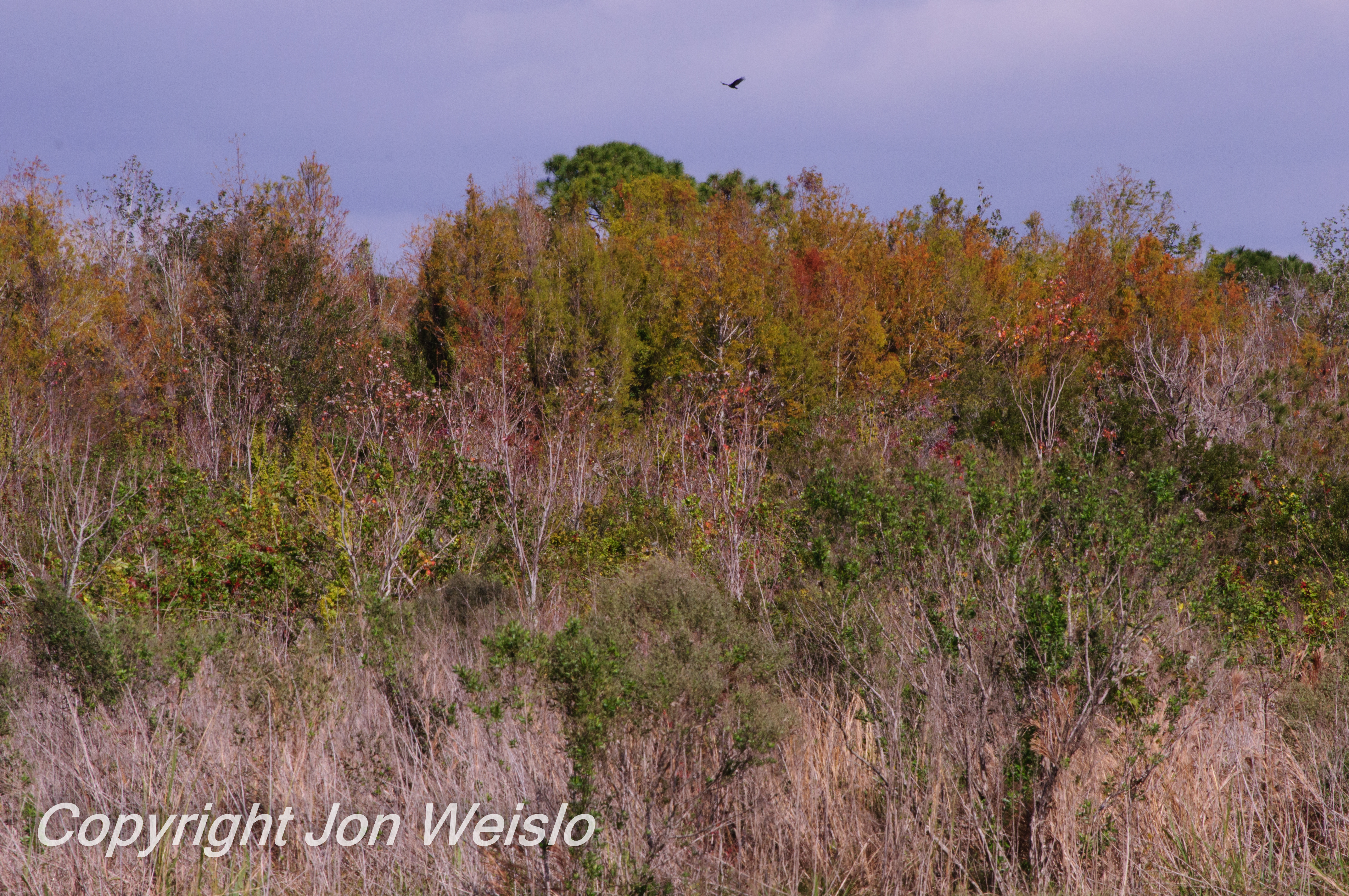

Associated trees and plants include ash, water hickory, cypress, holly, maples, oaks, sable palms, and bay trees, often with a dense understory of vines, ferns, and various herbaceous plants. In the canopy are the "air plants" - various bromeliads attached to tree branches and trunks. In South Florida, orchids and ferns also populate the hardwood swamps dense canopy. The tree canopy holds in humidity thus creating its own mico-climate.